Crayfish, Swedish-style
Crayfish, Swedish-style
-
-
-
-
-
Crayfish, Swedish-style
-
Post #1 - August 10th, 2006, 4:25 pmSwedes have been eating crayfish for a long time. It's said that monks in the medival Sweden ate large amounts of crayfish, especially during periods of dietary restrictions - the flesh is meaty but was still considered a type of fish. Apparently, the crayfish were eaten warm (similar to how they are eaten in the Southern U.S.) until sometime near the end of the 1800's when they began to be prepared and served as they are today - cold and in a seasoned brine.
Crayfish eventually became so popular that restrictions had to be made to ensure that they didn't disappear. The 8th of August was determined to be the date from which crayfish fishing could be allowed. And, despite lifting restrictions in 1993, August is still the time for crayfish parties in Sweden.
One more note of interest (?) before getting to the cooking. Native crayfish, (Astacus astacus), nearly disappeared in the early 1900's due to its susceptability to a north American fungus-like organism (Aphanomyces astaci) that probably came to Sweden when someone released north American crayfish (Pacifastacus leniusculus) into Swedish waters. North American crayfish are not bothered by the fungus but do carry it. Subsequently, North American crayfish were properly introduced to Swedish waters beginning in 1969 in order to replenish crayfish stocks, regardless of type. It turns out that several rivers and lakes were spared from the fungus and one can these days purchase native Swedish crayfish for twice the price of north American (750 kronor/kilo as opposed to 370, or over 50 bucks per pound vs. 25!).
I was at the market today in Stockholm looking to purchase some freshly boiled crayfish when I spotted a store-owner filling a pot with live crayfish. Finding live crayfish in Stockholm without actually fishing them yourself is truly a rarity as they are always sold pre-boiled. However, after several minutes of discussion (they were shocked to hear from someone wanting to purchase living crayfish), I walked away with nearly 5 pounds of live crayfish. As our crayfish party is planned for tomorrow evening, there wasn't much to do but rush home, boil them and let them soak in their brine overnight.
At home, ingredients were assembled:
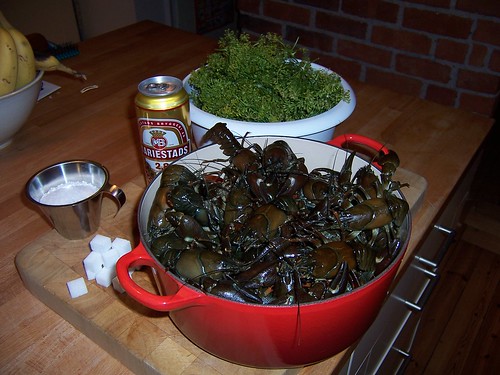
Salt, sugar, cheap Swedish lager, nearly two pounds of dill umbels and the frisky crayfish.
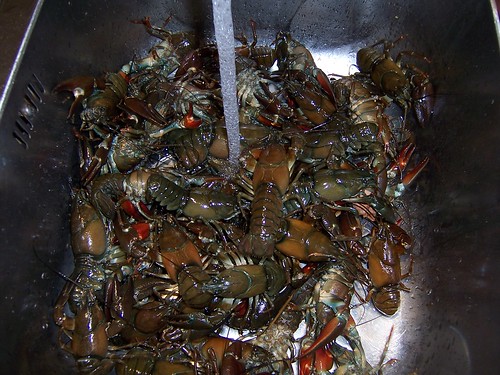
These came spotless from the store but it's still a good idea to give them a little wash.
A simple stock is made by combining the salt, about half of the dill and 5 quarts of water and bring to a rapid boil.
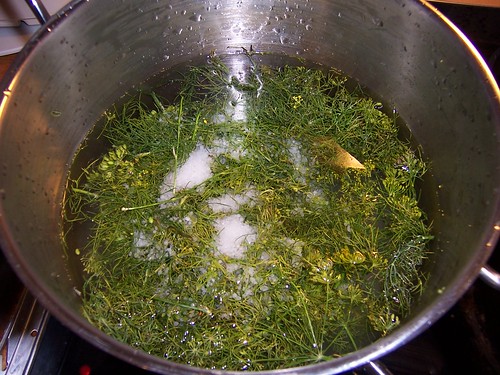
Then, it's time to come to grips with what being at the top of the food chain really means and boiling the little creatures. After about 6 minutes:
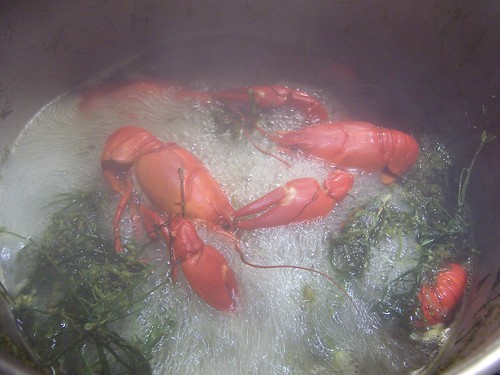
(I tried to make for an easier passage by boiling in small batches - about 6 at a time - and taking them directly from the refridgerator.)
After boiling, it's time to strain the stock, discard the boiled dill and add the beer and the sugar to the still-hot liquid. Layer the boiled crayfish with the remaining, non-boiled umbels:
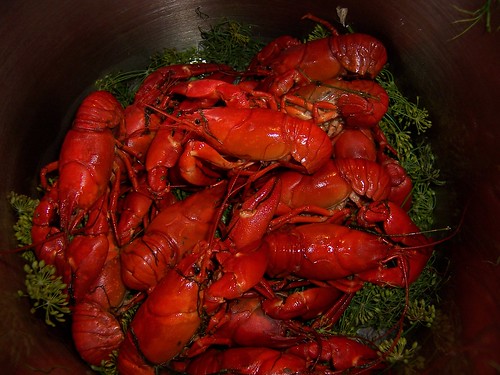
And add the stock/beer/sugar mixture to cover:
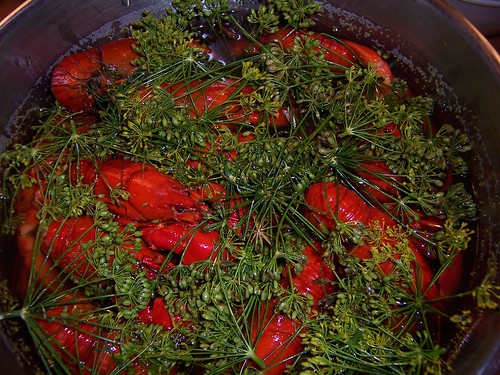
These went directly into the refridgerator and will remain there until the party tomorrow night.
I did, however, sneak a taste! The still-hot crayfish I tasted was wonderful. The boiling liquid is very salty, slightly sweet and tastes strongly of dill (think dill pickles more than the taste of dill fronds). Just enough of it remains on the shell to season the tail and clay meat while extracting it to provide perfect seasoning.
I hope to be able to provide pictures and a description of tomorrow's party later.Last edited by Bridgestone on August 10th, 2006, 10:17 pm, edited 1 time in total.
-
-
Post #2 - August 10th, 2006, 4:31 pmYour posts are among my favourite.
Thank you for your effort.
E.M.
-
-
Post #3 - August 10th, 2006, 4:46 pmHI,
These are 'scampi' Buzara style as I have had them in Croatia. Are these roughly the same critters?
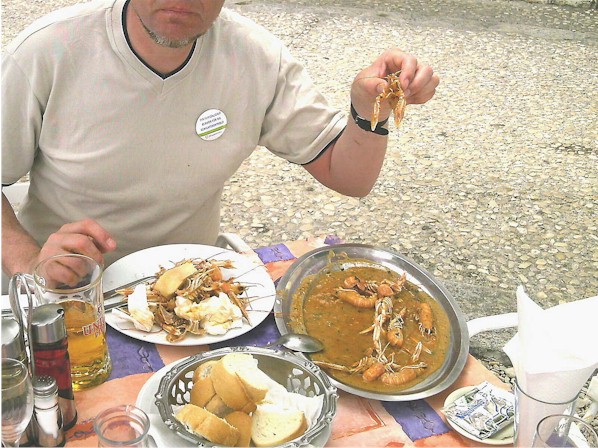
I have always had these in restaurants.
Regards,Cathy2
"You'll be remembered long after you're dead if you make good gravy, mashed potatoes and biscuits." -- Nathalie Dupree
Facebook, Twitter, Greater Midwest Foodways,
-
-
Post #4 - August 10th, 2006, 9:06 pmFanstastic post. Great photos.
But, really, why would you do this to live mudbugs? Boiling is fine but the soak? Shouldn't this method be reserved for the frozen crawfish? I'd think you'd want to eat live seafood moments after its been cooked. I'm sure there are reasons and I could speculate, but I'd like to hear your response.
-ramon
nb: I find dill vile!
nbb: I read somewhere recently that the usage of "ps" was "gay."
nbbb: But I've gotta thang for the hostess of New Scanidinavian Cooking on pBS. She must have dilly breath.
nbbbb: I get secret cravings for candy swedish fish.
-
-
Post #5 - August 10th, 2006, 10:34 pmGreat photos. But the species we get in Wisconsinare Orconectes rusticus ... is that even vaguely related to Astacus astacus, or Pacifastacus leniusculus?
And. more importantly. am I getting way too geeky, even for LTH?
-
-
Post #6 - August 10th, 2006, 11:19 pmErik M. - Thank you and likewise!
Cathy2 - Although their claws are much smaller (perhaps they are young/immature?), your "scampi" look, to me, much like salt-water langoustines and not fresh-water crayfish. But, taste-wise, that's just splitting hairs as they are very similar creatures. The Swedish word for "langoustine" is actually "havskräfta" which actually translates to "sea crayfish".
Ramon - Hmmm... The short answer is "tradition". It's simply how crayfish are served over here and the salty, dill-flavored brine is probably and in all honesty more important than the crayfish themselves.
But the long answer needs to look at why this method would become tradition. I only have a few guesses...
August was/is known as "rötmånanden" (or, "the rotting month") in Sweden. With temperatures regularily in the 80's, it's warmer than any other time of the year. It is also moderately humid. These warm 3-4 weeks probably caused near-havoc for generations past. Sweden's beloved dairy and cured-pork products suddenly and quickly spoiled and wells and other sources of water became unhealthy (or at least unpalatable) to drink. Now, this would seem to be an argument for eating piping hot crayfish as opposed to cool crayfish if not for a few reasons: 1) the ability to serve piping hot crayfish straight from stove/fire to tabletop is a reasonably recent development and eating a warmish crayfish that had sit even for an hour would not have been wise, 2) eating any fish or shellfish during "rötmånaden" was seriously frowned upon as the assumption in the 1700's was that they were actually poisonous during this period and not simply spoiled so a serious bout of "treatment" was in store.
Why salty/sweet and with dill? Well, salty/sweet is one of the Swedish kitchen's bases. I believe that it goes back to a time when both salt and sugar were imported and expensive. Party/holiday food = pull out the stops = sugar and salt. Sugar and salt are both preservatives and that helps significantly in regards to the above-mentioned problem with August and spoilage. My guess regarding the dill umbels is simply that dill umbels is what people had on hand. There weren't/aren't too many herbs or spices that thrive (or even grew in the 18th century Sweden) in the Swedish climate but dill is one of them. Dill goes to seed (hence the umbels) right around the beginning of August.
I suppose that the last aspect of your question, Ramon, is "why follow tradition?". Well, for the same reason I see people turning Waygu briskets into barbeque (or corned beef) or Kurobuta pork into homemade sausages. The tastes found in traditional dishes are hard to beat (they've survived many generations of finicky cooks) and a modern accessibility to high-quality ingredients shouldn't limit the use of these old recipes/traditions. At least not in my book!
-
-
Post #7 - August 10th, 2006, 11:26 pmYour posts are among my favourite.
Seconded--Looking forward to many more (with swedish beer!)
Enjoying the history/etymology as well.Writing about craft beer at GuysDrinkingBeer.com
"You don't realize it, but we're at dinner right now." ~Ebert
-
-
Post #8 - August 11th, 2006, 7:52 amBridgestone,
In Sweden are crayfish still eaten by the "suck the head, pinch the tail" method?
Flip"Beer is proof God loves us, and wants us to be Happy"
-Ben Franklin-
-
-
Post #9 - August 12th, 2006, 3:10 pmThanks for the encouragement, folks!
nr706 - After a quick Google I read that the United States alone has over 415 species of crayfish. That's about 413 more than I would have dreamed existed. I did read that Pacifastacus leniusculus is, in fact, the correct species of the crayfish that was successfully transplanted from the U.S. to Sweden in the 1960's, though. I suppose that all of these species are "vaguely related".
Flip - "Suck the head, pinch the tail" is a pretty good description. It's actually quite an art. The crayfish is picked up and one is to first take an initial slurp from the creature's belly (where all of the legs join it's body). This is primarily to get a taste of the brine. You may then immediately pinch off the tail and squeeze it to crack the shell and access the meat or carefully lift off the main body shell to get access to any innards one may want to indulge in. Large claws may then be bitten, cracked and sucked to remove the small lumps of meat in them. My experience is that one begins thoroughly and gradually goes over to only eating the tails as the night goes on...
Well, just a few random pics from the rest of the evening.
Here's the crayfish after their 24-hour soak in the brine:
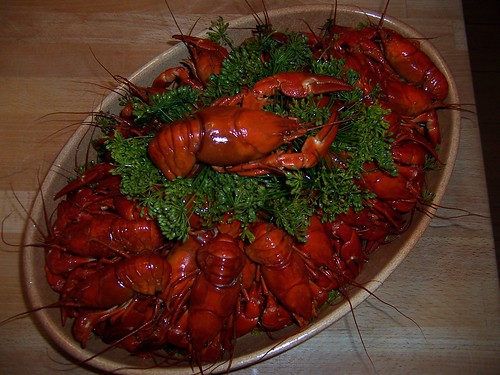
Crayfish are normally served with baguettes, salad, cheese and beer/snaps. One traditional choice of cheese would be "kryddost" (literally, "spice cheese") which is made from the local, semi-hard variety "svecia" that's had caraway seeds and cloves added to it:
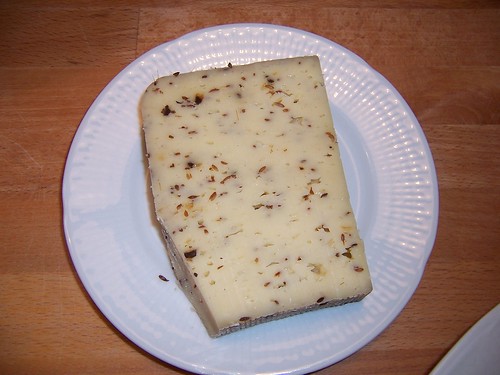
However, I picked up a few other cheeses when I was at the market:
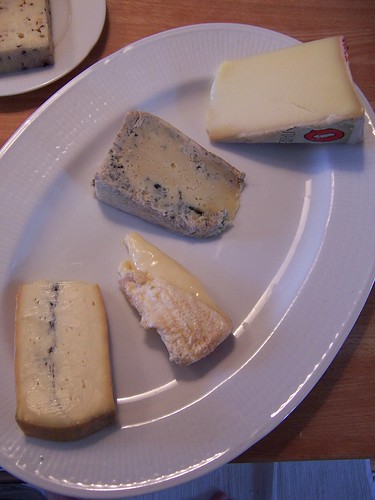
From the bottom left up: 1) an aged, raw-milk Morbier, 2) an extremely ripe Epoisses, 3) a bit of Cabrales, and 4) a 2-year old Beaufort.
As evening began to settle in, it was time to gather the neighbors together and start the party!


With all of the talking, snaps and singing, dinner takes time. This is, however, welcome as by the beginning of August, the nights are turning black again and by midnight everyone is content to pull on a sweater, sit and chat in the cozy candlelight.

